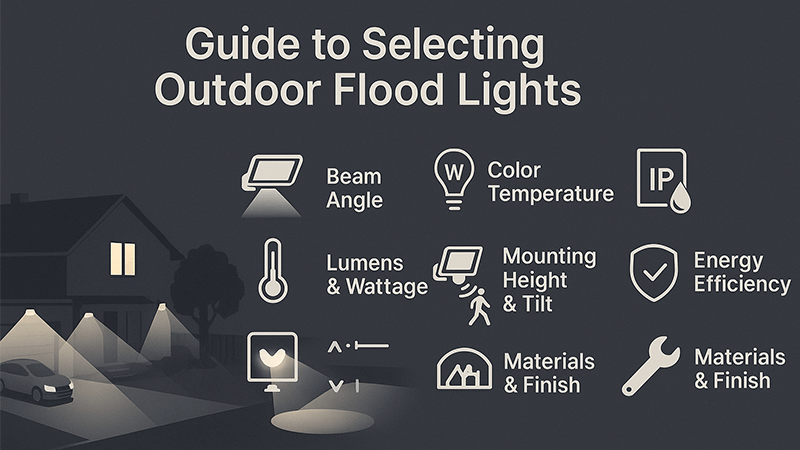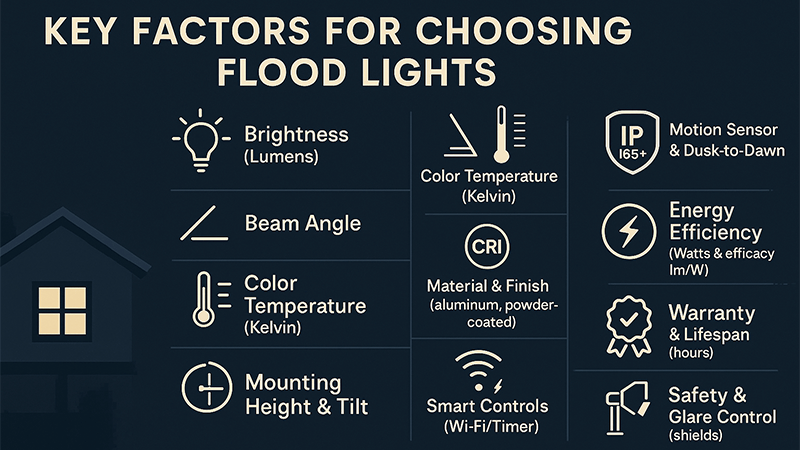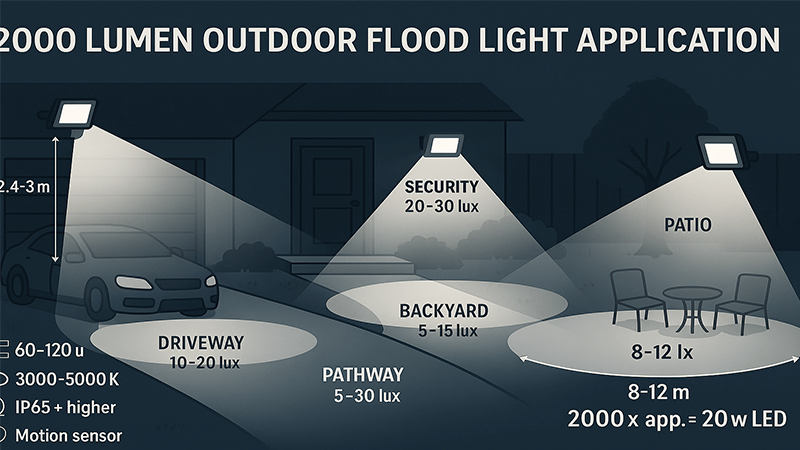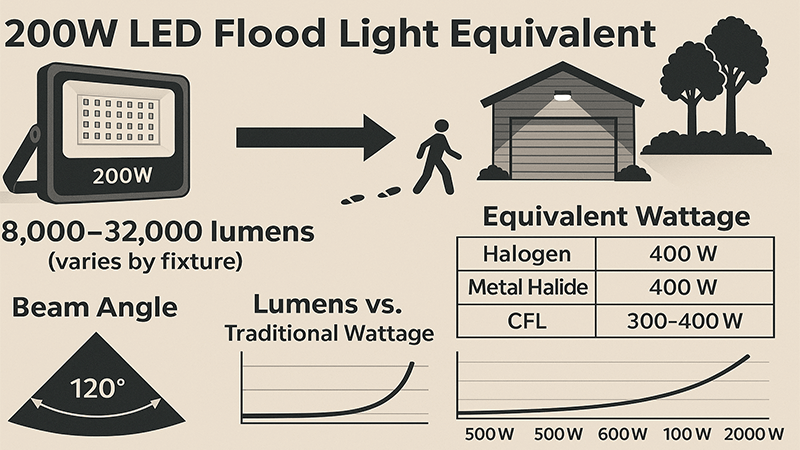Choosing the right outdoor flood light feels overwhelming. A wrong decision can lead to poor security, high energy bills, or unhappy clients. Let’s simplify the process together.
To choose an outdoor flood light, focus on the area you need to illuminate and the brightness required. Key factors to consider are lumens (brightness), beam angle (coverage), color temperature (CCT), and IP rating (weatherproofing). Always prioritize lumens over wattage for modern LED lights.

Picking the perfect flood light is a critical step for any project, whether it’s for security, aesthetics, or general illumination. Getting it right means a safe, well-lit space and a satisfied customer. I’ve spent my entire career in LED lighting manufacturing, and I’ve seen how a few key details can make all the difference. Let’s break down exactly what you need to look for, so you can make your next purchase with complete confidence.
How do I choose outdoor flood lights?
Finding the right flood light seems complex with so many options. You worry about picking one that’s too dim or fails in bad weather. Follow a simple checklist.
Choose outdoor flood lights by evaluating five key factors: lumens for brightness, beam angle for coverage area, color temperature for light color, IP rating for weather resistance, and wattage for energy use. Match these specifications to your project’s specific needs for the best results.

In my years of helping clients source lighting, I’ve seen that success comes from a methodical approach. It’s not about finding a single "best" light; it’s about finding the right light for the job. Let’s go deeper into the essential factors you must consider. My advice is to always start with the desired outcome: what do you want the light to do? From there, we can work backward to the specifications. Remember, a slightly brighter light is often better for outdoor spaces because ambient light from streets or the moon can reduce its perceived brightness.
Key Specifications to Check
When you’re looking at a spec sheet, these are the numbers that matter most. I always tell my partners to create a simple checklist for each project to ensure nothing gets missed.
- Lumens (Brightness): This is the most important factor. It measures the total amount of visible light from a source. More lumens mean a brighter light.
- Beam Angle: This tells you how wide the light will spread. A narrow beam (e.g., 45°) is for spotlighting specific features, while a wide beam (e.g., 120°) is for illuminating large areas like a parking lot.
- Color Temperature (CCT): Measured in Kelvin (K), this defines the color of the light. 3000K is a warm white, 4000K is a neutral white, and 5000K-6000K is a cool, daylight-like white often used for security.
- IP Rating (Weatherproofing): The Ingress Protection rating indicates how well the fixture is sealed against dust and water. For outdoor use, you should look for IP65 or higher, which means it’s dust-tight and protected against water jets.
Here is a simple table to help guide your decisions:
| Factor |
Low Requirement (e.g., Walkway) |
Medium Requirement (e.g., Backyard) |
High Requirement (e.g., Parking Lot) |
| Lumens |
1,000 – 3,000 lm |
3,000 – 8,000 lm |
10,000 – 30,000+ lm |
| Beam Angle |
60° – 90° |
90° – 120° |
120° or wider |
| CCT |
3000K (Warm White) |
4000K (Neutral White) |
5000K (Cool White) |
| IP Rating |
IP65 |
IP65 or IP66 |
IP66 or IP67 |
By breaking it down like this, you can turn a complicated decision into a simple process of matching your project needs to the product specifications.
Is 2000 lumens bright enough for outdoor lighting?
You need to light a small area but are unsure about brightness. Choosing a light that’s too dim can defeat its purpose, leaving areas in shadow and compromising security.
Yes, 2000 lumens is bright enough for many small-scale outdoor applications. It is ideal for lighting up doorways, small patios, garden features, or residential driveways. However, for larger areas like a backyard or commercial space, you will need a higher lumen output.

The question of "how bright is bright enough?" is one I get all the time. The answer always depends on the context of the space. A 2000 lumen flood light can seem incredibly bright when lighting a single entryway, but it would feel completely inadequate if you were trying to light up a tennis court. Understanding the application is everything. When I started in this industry, we often had to guess and over-spec to be safe. With LEDs, we can be much more precise.
Understanding Lumen Application
To give you a better real-world perspective, let’s compare different lumen levels and their common uses. Think of lumens as the raw power of the light. How you use that power depends on the height of the installation and the size of the target area. A 2000 lumen light is a great utility player for residential projects. It’s roughly equivalent to a traditional 120-150 watt incandescent bulb but much more focused and efficient.
Here’s how 2000 lumens fits into the broader landscape of outdoor lighting:
- Doorways and Entrances: Perfect for ensuring safe entry and deterring intruders. The light is bright enough to see keys and faces clearly without being blinding.
- Accent Lighting: Excellent for highlighting architectural details, trees, or garden statues. The focused brightness draws attention effectively.
- Small Patios or Decks: It can provide enough general illumination for a small seating area, creating a safe and usable space after dark.
To help you visualize, here’s a comparison of common lumen outputs and their typical applications.
| Lumen Range |
Common Applications |
Traditional Equivalent (Approx.) |
| 700 – 1,500 lm |
Path lighting, step lights, small accent lights |
60-100W Incandescent |
| 1,500 – 3,000 lm |
Doorways, small driveways, garden features |
100-200W Incandescent |
| 3,000 – 8,000 lm |
Backyards, larger driveways, building facades |
250W Halogen |
| 8,000 – 15,000 lm |
Small parking areas, building security |
400W Halogen |
| 15,000+ lm |
Large parking lots, sports fields, commercial yards |
1000W Metal Halide |
For a purchasing manager like Shaz, having these benchmarks helps in specifying the right products for different project scales, ensuring you’re not overpaying for unnecessary brightness or under-delivering on safety.
What is the best wattage for outdoor flood lights?
You see wattages listed everywhere, making you think it’s the key measure of performance. But focusing on watts for LEDs is a mistake that can lead to buying inefficient, outdated lights.
There is no single "best" wattage. For LED flood lights, focus on lumens (brightness) and luminous efficacy (lumens per watt) instead. A higher efficacy means you get more light for less energy. Choose the lumens you need, then find the lowest wattage that provides it.

Back when we only had incandescent or halogen lights, wattage was a reliable proxy for brightness. A 100W bulb was always brighter than a 60W bulb. I remember walking through the factory floor and everything was categorized by wattage. But with LED technology, that’s no longer true. The efficiency of LED chips and drivers varies dramatically. A high-quality 100W LED flood light from my factory could be brighter than a low-quality 120W one from another. This is why I always tell my clients to shift their thinking from "how many watts?" to "how many lumens?"
Efficacy: The Real Measure of Performance
The most important metric to understand here is luminous efficacy, measured in lumens per watt (lm/W). This number tells you how efficiently a light fixture converts electrical energy (watts) into light (lumens). A higher number is always better. It means lower energy bills and a more advanced product.
Let’s break down why this matters for your purchasing decisions:
- Cost Savings: A fixture with high efficacy uses less electricity to produce the same amount of light, leading to significant long-term savings on energy costs.
- Technology Indicator: High lm/W ratings are usually a sign of newer, better-quality LED chips and driver technology. These fixtures often have longer lifespans and better reliability.
- Accurate Comparison: Comparing two 100W flood lights is meaningless without knowing their lumen output. Comparing them by lumens and efficacy gives you a true side-by-side assessment.
Here is a table showing typical wattage ranges for common outdoor applications, along with the lumen output you should expect from a quality fixture.
| Application |
Typical LED Wattage |
Expected Lumen Output |
Luminous Efficacy (lm/W) |
| Residential Driveway |
20W – 40W |
2,500 – 5,000 lm |
>120 lm/W |
| Building Facade |
50W – 100W |
6,000 – 13,000 lm |
>130 lm/W |
| Small Parking Lot |
100W – 150W |
13,000 – 21,000 lm |
>130 lm/W |
| Large Commercial Area |
200W – 300W |
28,000 – 45,000 lm |
>140 lm/W |
When sourcing products, always ask for the luminous efficacy. It’s a simple number that tells you a lot about the quality and performance you’re paying for.
What is a 200W LED flood light equivalent to?
You’re replacing old, power-hungry lights and need to find the right LED equivalent. Picking the wrong one can result in poor lighting and missed energy savings.
A 200W LED flood light is typically equivalent to a 400W metal halide (MH) or high-pressure sodium (HPS) lamp. In some cases, depending on its high luminous efficacy, it can even replace fixtures up to 1000W, offering massive energy savings.

I’ve helped hundreds of clients transition from traditional lighting to LED. The most satisfying part is showing them the dramatic reduction in energy consumption. A 200W LED is a real workhorse in the commercial and industrial space, and its replacement power is often misunderstood. People see "200W" and compare it to a 200W traditional bulb, but that’s not how it works. LED technology is far more efficient at directing light where it’s needed, meaning you get more usable light (lumens) from every watt of energy.
A Deeper Look at Equivalency
The "equivalency" isn’t just about matching lumen output. While a 200W LED might produce 28,000 lumens, and a 400W MH might also produce around 30,000 lumens initially, the story doesn’t end there.
Here are the key advantages of making the switch:
- Lumen Depreciation: Metal halide lamps lose brightness quickly. After just a few thousand hours, that 400W MH might only be producing 60-70% of its initial lumens. LEDs maintain their brightness for much longer, typically over 50,000 hours.
- Energy Savings: The most obvious benefit. A 200W LED uses at least 50% less energy than a 400W MH fixture (which actually consumes more than 400W because of the ballast). Over the light’s lifespan, this saves thousands of dollars.
- Maintenance Costs: Traditional lamps need frequent bulb and ballast replacements. LED fixtures are integrated and can last for over a decade without any maintenance, saving on labor and material costs.
- Light Quality: LEDs provide a much better Color Rendering Index (CRI), meaning colors appear more natural and vibrant. They also offer instant-on capability without any warm-up time.
Let’s compare a high-quality 200W LED flood light directly with its traditional counterpart:
| Feature |
200W LED Flood Light |
400W Metal Halide Flood Light |
| Actual Power Draw |
~200 Watts |
~450 Watts (with ballast) |
| Initial Lumens |
26,000 – 30,000 lm |
30,000 – 36,000 lm |
| Lifespan |
50,000 – 100,000 hours |
10,000 – 15,000 hours |
| Lumen Maintenance |
L70 at 50,000+ hrs (70% bright) |
65% bright at 8,000 hrs |
| Maintenance Needs |
Virtually none |
Frequent lamp/ballast changes |
| Warm-up Time |
Instant |
5-10 minutes |
When you show this comparison to a project contractor or facility manager, the decision becomes clear. The 200W LED isn’t just an equivalent; it’s a massive upgrade in every important metric.
Conclusion
Choosing the right outdoor flood light is simple when you focus on lumens, beam angle, and IP rating. Match these to your project needs for perfect, efficient illumination every time.